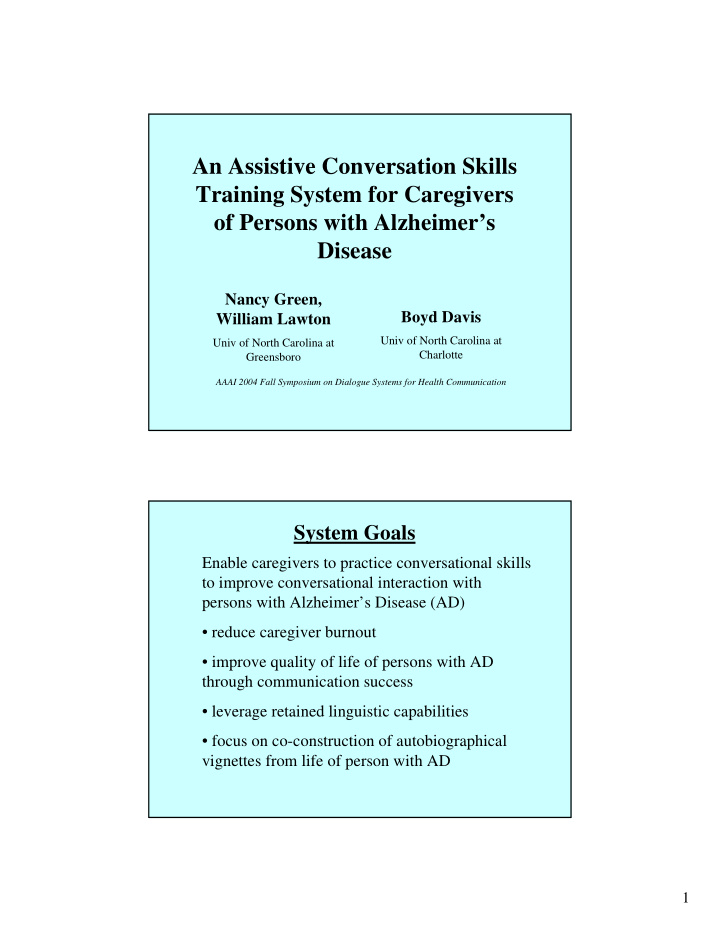



An Assistive Conversation Skills Training System for Caregivers of Persons with Alzheimer’s Disease Nancy Green, Boyd Davis William Lawton Univ of North Carolina at Univ of North Carolina at Charlotte Greensboro AAAI 2004 Fall Symposium on Dialogue Systems for Health Communication System Goals Enable caregivers to practice conversational skills to improve conversational interaction with persons with Alzheimer’s Disease (AD) • reduce caregiver burnout • improve quality of life of persons with AD through communication success • leverage retained linguistic capabilities • focus on co-construction of autobiographical vignettes from life of person with AD 1
Proposed Training System CG ADA Agent Agent simulating representing person with caregiver Alzheimer’s Simulated dialogue Disease Trainee (actual caregiver) Training Requirements: User Perspective • Caregivers: family or institutional • Improved access to training • Improved motivation through user engagement • Transfer of skills to real life • Appropriate for different cultural backgrounds • Usable for low-literacy, first-time computer users • (in future) deliver in languages for non-English speakers 2
Training Requirements: Linguistic For Alzheimer’s character: realistic model of • difficulties in comprehending caregiver, e.g. • direct question ( Where did you get it? ) vs. indirect question ( Your daughter gave it to you, didn’t she? ) • production difficulties, e.g. lexical vagueness • use of dialogue coping strategies • use of sociolinguistic variation (age, gender, ethnic) • reaction to caregiver’s part of dialogue (including positive/negative affect) • use of autobiographical storytelling cues Training Requirements: Linguistic For caregiver: • learn to respond helpfully to communication impasses, e.g., use of history and context to interpret vague referring expressions • learn to leverage retained capabilities of conversational partner with AD • learn strategies for co-constructing autobiographical vignettes, e.g., • recognizing phrases used in previous telling • so-questions 3
Work in Progress • Longitudinal data collection and analysis : on-going project to record & transcribe monthly conversations with persons with AD; analysis of linguistic features of discourse of AD and effectiveness of different conversational interventions (Davis and various colleagues, UNC Charlotte) • Prototype development : developed prototype architecture using off-the-shelf components (Prolog, MS Agent); now implementing prototypes for experimentation (Green & Lawton, UNC Greensboro) • Formative evaluation of prototypes’ ease of use and believability with CNAs, etc. (Davis & Green) Screen Shot of Prototype 4
Dialogue Generation in Prototype v. 2 • Script : directed graph implementing one vignette • arc: (Agent, Precondition, Action, Agent-Effect, Beneficiary-Effect) • dialogue hand-coded based on corpus of transcripts • emotion mainly triggered in mental model • ADA (AD agent) & CG (Caregiver) agent • rule-based mental model of dialogue and social goals, and change in emotional state (positive-negative) • Director : queries mental models and script object, sends commands to animation, reads user’s choice of dialogue action Dialogue Generation Example 1 System takes arc 2 (no user choice required): • Agent: CG • Precondition: goal to begin-turn • triggers side-effect in CG model: goal to show interest • Action: (show-regard, “That’s a great shirt!”) • Agent effect: none • Beneficiary effect: adds effect of show-regard, resulting in increase in ADA’s happiness, eventually revealed by ADA’s body language (looks towards speaker) 5
Dialogue Generation Example 2 User chooses arc 4: • Agent: CG • Precondition: goal to begin-turn • triggers side-effect in CG model: goal to show interest • Action: (direct-question, “Where did you get it?”) • Agent effect: adds expectation of answer • Beneficiary effect: adds similar expectation but ADA will be unable to satisfy, resulting in decrease in ADA’s happiness, eventually revealed by ADA’s body language (looks away from speaker) Related Work • Graph-based script with user choice of action, narrative for user engagement: Carmen’s Bright Ideas (Marsella et al. 2000, 2003) • Conversational training for interaction with disturbed clients: JUST-TALK (Hubal et al. 2003) • Emotion modeling: JUST-TALK and MRE (Traum et al. 2004) • Interactional, attitudinal, relational function of dialogue: Laura (Bickmore 2003, 2004). 6
Future Work • Conversational agent • Computational model of story vignette co-construction • Computational cognitive model of Alzheimer’s discourse (parameterized for stages of AD) • Computational analysis of effectiveness of caregiver interventions in transcripts • More fine-grained control of gesture and animation • Enhanced user input modalities (especially speech) • Evaluation Conclusions • Strong potential to improve interaction between persons with AD and caregivers • Testbed for research in AI/Dialogue, computational modeling of AD, pedagogical efficacy of virtual training environments 7
Effects of Alzheimer’s Disease on Conversational Ability For example (Perkins et al. 1997): • Turn-taking Skills : cannot initiate conversation, failure to respond when selected as next speaker • Topic Management : ability to initiate new topics, ability to maintain topic • Memory : failure to remember persons or events discussed in conversation • Language Production : failure in word retrieval, inability to produce referring expressions other than pronouns 8
Recommend
More recommend